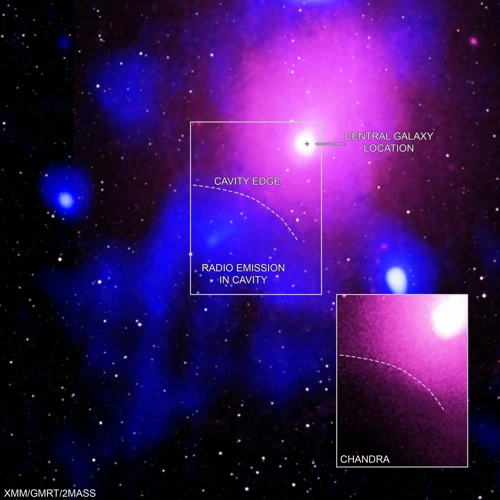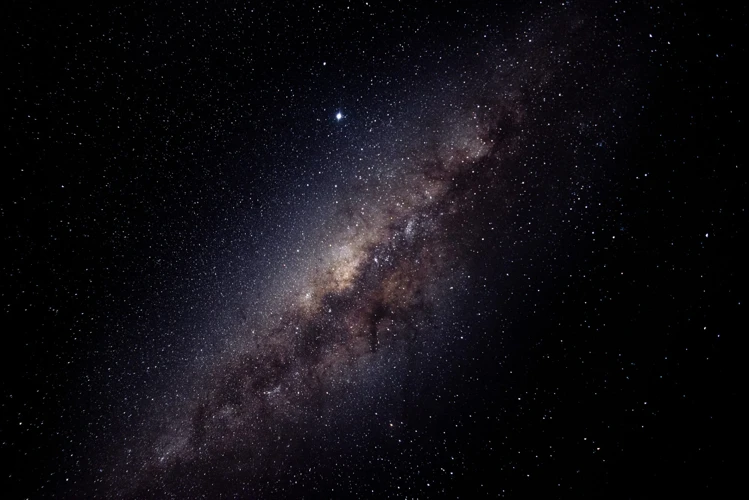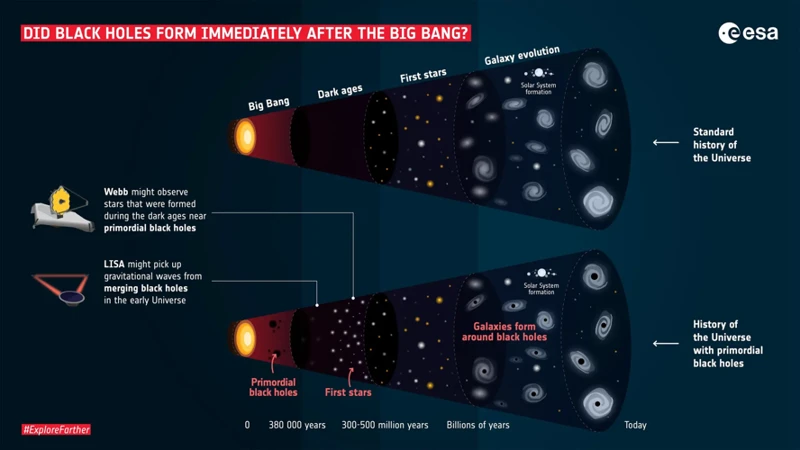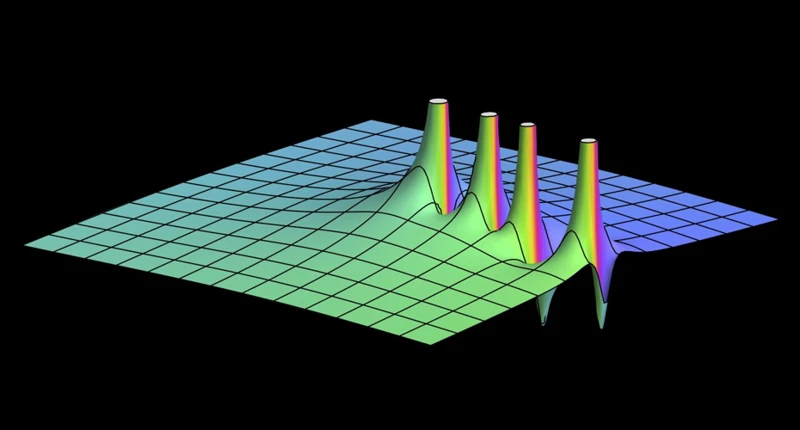The mysteries of the universe never cease to captivate the human mind. Among the most enigmatic phenomena are black holes and dark matter. These cosmic entities have long puzzled scientists and astronomers, but recent research has shed light on the connection between them. In this article, we will delve into the depths of black holes and explore the elusive nature of dark matter. By understanding the formation and properties of black holes, as well as the definition and distribution of dark matter, we can uncover the intriguing relationship between these two cosmic phenomena. Additionally, we will discuss the gravitational effects of black holes on dark matter and how dark matter may influence the formation of black holes. Join us on this cosmic journey as we unravel the mysteries that lie at the heart of our universe.
Contents
- Understanding Black Holes
- Exploring Dark Matter
- Black Holes and Dark Matter: The Connection
- Current Research and Theoretical Implications
- Conclusion
-
Frequently Asked Questions
- 1. How are black holes formed?
- 2. Can light escape a black hole?
- 3. What are the properties of black holes?
- 4. What is dark matter?
- 5. How is dark matter distributed in the universe?
- 6. Can dark matter be detected?
- 7. How do black holes interact with dark matter?
- 8. Can dark matter influence the formation of black holes?
- 9. What are the current research areas and theoretical implications of the connection between black holes and dark matter?
- 10. What are the practical implications of understanding the connection between black holes and dark matter?
- References
-
Frequently Asked Questions
- 1. What is the relationship between black holes and dark matter?
- 2. How are black holes formed?
- 3. What are the properties of black holes?
- 4. What is dark matter?
- 5. What are the properties of dark matter?
- 6. How is dark matter distributed in the universe?
- 7. How does gravity affect dark matter?
- 8. How does dark matter influence the formation of black holes?
- 9. What are the current research efforts and theoretical implications regarding the connection between black holes and dark matter?
- 10. What are the potential implications of a deeper understanding of the connection between black holes and dark matter?
- References
- Read More
Understanding Black Holes

Black holes are fascinating astronomical objects that defy our traditional understanding of physics. They are formed through various processes, one of which is the collapse of massive stars. When a star with several times the mass of our sun reaches the end of its life, it undergoes a gravitational collapse, causing it to become an incredibly dense and compact object. The gravitational pull of black holes is so strong that nothing, not even light, can escape their grasp. This phenomenon, known as the event horizon, creates a point of no return. Black holes come in different sizes, ranging from stellar black holes, which are a few times the mass of the sun, to supermassive black holes, which can be millions or even billions of times more massive. Despite their intriguing nature, there is still much to learn about black holes, and researchers continue to explore their properties and behavior. Stay tuned as we dive deeper into the fascinating world of black holes and their connection to dark matter.
1. Formation of Black Holes
The formation of black holes is a captivating process that occurs under specific conditions in the universe. One of the primary mechanisms for black hole formation is the collapse of massive stars. When a star exhausts its nuclear fuel, the inward gravitational force becomes dominant, causing the star to undergo a catastrophic collapse. This collapse leads to the formation of a singularity, a point of infinite density at the center of the black hole. The singularity is surrounded by an event horizon, which marks the boundary beyond which nothing, not even light, can escape the gravitational pull of the black hole. This remarkable formation process is fueled by the immense gravitational forces at play, causing the star to condense into an incredibly small and dense object. Stellar black holes, which are formed through this process, have masses ranging from a few times that of the sun to around 20 times its mass.
It is important to note that black holes can also form through other mechanisms, such as the collision of two neutron stars or the gravitational collapse of dense regions within galaxies. Each formation scenario contributes to the diversity of black holes observed in the universe. By studying these different formation mechanisms, scientists gain insight into the evolution of stars, the dynamics of galaxies, and the intricate workings of the cosmos. The formation of black holes is a remarkable phenomenon that offers a glimpse into the immense power and complexity of the universe. As we continue our exploration of the connections between black holes and dark matter, we will uncover more about the fascinating origins of these cosmic enigmas.
2. Properties of Black Holes
Black holes possess several unique properties that set them apart from any other known celestial objects. One of the key properties of black holes is their immense gravitational pull. Due to their high mass packed into a small volume, black holes have an incredibly strong gravitational force that can distort space-time. This gravitational force is so powerful that it can bend light rays, causing the phenomenon known as gravitational lensing. Another property of black holes is their event horizon, which is the boundary beyond which nothing can escape their gravitational pull, not even light. The event horizon is determined by the mass of the black hole, with larger black holes having a larger event horizon. As a result, the event horizon acts as a point of no return, trapping anything that crosses it.
Black holes also have a property called “spin” or angular momentum. This refers to their ability to rotate on their axis. The spin of a black hole affects its shape and gravitational field. The faster a black hole spins, the more it drags nearby space and objects, including light, creating a rotational frame-dragging effect. Additionally, black holes also possess a property called electric charge, although it is believed that most black holes in the universe are electrically neutral.
Understanding these properties of black holes is a crucial step in comprehending their role in the universe and their connection to other cosmic phenomena. Researchers continue to study and analyze these properties to gain further insights into the nature of black holes and the mysterious forces that govern them. Stay tuned as we dig deeper into the intriguing world of black holes and their fascinating relationship with dark matter.
Exploring Dark Matter

Dark matter is a mysterious substance that constitutes a significant portion of the universe. Unlike ordinary matter, which consists of atoms, dark matter does not interact with light and is thus invisible. Scientists have been able to infer the existence of dark matter through its gravitational effects on visible matter and the structure of the universe. The properties of dark matter remain elusive, but research suggests that it is non-baryonic, meaning it is not composed of protons and neutrons like the matter we are familiar with. It is postulated that dark matter plays a crucial role in the formation and evolution of galaxies and galaxy clusters. Through observations and simulations, astronomers have discovered that dark matter forms a vast cosmic web, with dense regions known as dark matter halos. These halos provide the scaffold upon which galaxies assemble and organize. Although dark matter has not yet been directly detected, ongoing experiments and observations strive to uncover its nature and decipher its role in the cosmic tapestry. Join us as we delve into the depths of this enigmatic substance and its captivating connection to black holes.
1. Definition and Properties of Dark Matter
Dark matter is a perplexing concept that has captivated the attention of scientists for decades. Although it cannot be directly observed, its existence is inferred through its gravitational effects on visible matter and light. Dark matter is believed to make up a significant portion of the universe, accounting for about 85% of all matter. This enigmatic substance does not emit, absorb, or reflect light, hence its name. It behaves differently from ordinary matter, as it does not interact with electromagnetic radiation, making it invisible to conventional telescopes. The properties of dark matter are still largely unknown, but scientists have proposed various theories to explain its nature. It is thought to be non-baryonic, meaning it is not composed of the same subatomic particles as protons and neutrons. Instead, it is postulated to be made up of exotic particles that have yet to be discovered. Dark matter is also known for its gravitational influence on galaxies and galaxy clusters, causing them to rotate faster than expected and enabling the formation of cosmic structures. Despite ongoing efforts, the exact composition and properties of dark matter remain shrouded in mystery. However, scientists continue to pursue research and experiments in the hopes of unraveling the secrets of this elusive substance.
2. Dark Matter Distribution
Dark matter, as the name suggests, is a form of matter that does not emit or reflect light, making it invisible to traditional astronomical observations. Its presence can only be inferred through its gravitational effects on visible matter and celestial objects. Understanding the distribution of dark matter is crucial in unraveling its nature. Scientists believe that dark matter is distributed in a web-like structure known as the cosmic web. This cosmic web consists of interconnected filaments that stretch across the universe, with dense knots of dark matter at the intersections. These filaments serve as highways for the formation of galaxies and galaxy clusters. The distribution of dark matter is not uniform, with denser regions attracting more visible matter, leading to the formation of galaxies and other cosmic structures. Advanced computer simulations and observations of galaxy clusters have provided insights into the distribution of dark matter and its role in shaping the large-scale structure of the universe. By studying the distribution of dark matter, astronomers can gain valuable clues about its composition and its influence on the evolution of the cosmos. The connection between dark matter and black holes is a fascinating area of research that is shedding light on the mysterious properties of both cosmic phenomena.
Black Holes and Dark Matter: The Connection

The connection between black holes and dark matter is an intriguing field of study that has captivated astronomers and physicists alike. Dark matter, which accounts for a significant portion of the universe, is a mysterious substance that does not interact with light or other forms of electromagnetic radiation. It is believed to have a gravitational influence on the formation and behavior of galaxies, but its exact nature and composition remain unknown. Recent research suggests that black holes, with their immense gravitational pull, may play a role in the distribution and dynamics of dark matter. The gravitational effects of black holes can cause the accumulation or dispersion of dark matter in their vicinity, shaping the overall dark matter distribution in the universe. It is theorized that dark matter might have played a crucial role in the formation and growth of black holes. The exact mechanisms and interactions between black holes and dark matter are still being investigated, but these connections provide fascinating insights into the nature of our universe. Join us as we delve deeper into the intricate relationship between black holes and dark matter and unravel the cosmic enigma that binds these two phenomena together.
1. Gravitational Effects on Dark Matter
Gravitational effects play a crucial role in understanding the behavior of dark matter. Dark matter, as its name suggests, does not interact with electromagnetic radiation and is therefore invisible to traditional telescopes. However, its presence can be inferred through its gravitational effects on visible matter. Scientists believe that dark matter makes up a significant portion of the total matter in the universe, far outweighing visible matter.
One of the key gravitational effects of dark matter is its ability to influence the large-scale structure of the universe. Dark matter acts as the scaffolding upon which galaxies and galaxy clusters form. Its gravitational pull attracts ordinary matter, causing it to clump together and form the cosmic structures we observe. This phenomenon is evident in simulations and observations, where the distribution of dark matter closely aligns with the locations of galaxies and galaxy clusters.
Dark matter can also affect the motion of visible matter within galaxies. Dark matter’s gravitational pull extends beyond the visible boundaries of galaxies, exerting a force that affects the motion of stars and gas clouds. This leads to the phenomenon known as galactic rotation curves, where the observed velocities of stars do not align with the predicted velocities based on the visible matter alone. The inclusion of dark matter in models allows for a better explanation of these rotation curves, indicating that dark matter’s gravitational effects are at play.
Understanding the gravitational effects of dark matter is crucial in unraveling its nature and distribution. By studying the interactions between dark matter and visible matter through gravitational lensing and other observational techniques, scientists can gain insight into the properties and behavior of this mysterious substance. The gravitational effects of dark matter provide a foundation for uncovering the intricate relationship between black holes and dark matter, as we will explore further in the subsequent sections.
Stay tuned as we dive deeper into the connection between black holes and dark matter, delving into the influence of dark matter on black hole formation and the implications of current research in this field.
2. Dark Matter Influence on Black Hole Formation
Dark matter, the mysterious substance that makes up a significant portion of the universe, has been found to have an influence on the formation of black holes. While black holes are primarily formed from the gravitational collapse of massive stars, the presence of dark matter in the surrounding regions can play a role in their formation and growth. Dark matter is known to cluster around galaxies and provides additional gravitational pull. This additional gravitational force can enhance the collapse of matter, leading to the formation of black holes. The interactions between dark matter and regular matter in these regions are complex and not yet fully understood. However, simulations and observations suggest that dark matter can contribute to the formation of supermassive black holes found at the centers of galaxies. These supermassive black holes are much larger than their stellar counterparts and are believed to have accumulated a tremendous amount of mass over time. The exact mechanisms through which dark matter influences the formation and growth of black holes are still being studied, and further research is needed to unravel the full extent of their connection. This fascinating interplay between dark matter and black holes opens up new avenues for exploring the intricate workings of our universe. To learn more about constellations, check out our constellations guide.
Current Research and Theoretical Implications

Current research in the field of black holes and dark matter has expanded our understanding of these cosmic phenomena and has led to intriguing theoretical implications. Scientists and astronomers are actively studying the gravitational effects of black holes on dark matter and its role in galaxy formation.
One area of research focuses on the interaction between black holes and dark matter at the galactic scale. It is believed that the gravitational pull of black holes affects the distribution of dark matter within galaxies. Studying this interaction can provide insights into the nature of both black holes and dark matter and their influence on the evolution of galaxies.
Another line of research explores the potential connection between the growth of black holes and the formation of dark matter halos. Dark matter halos are thought to be large concentrations of dark matter that surround galaxies and help shape their structure. Scientists are investigating whether the formation and growth of black holes play a role in the creation and evolution of these halos. Understanding this relationship could provide valuable information about the origin and behavior of dark matter.
In addition to observational studies, theoretical implications of the connection between black holes and dark matter are being explored. Various theoretical models and simulations are being developed to better understand the intricate relationship between these two cosmic entities. These models aim to explain the behavior of dark matter in the presence of black holes and how it influences the formation and evolution of galaxies.
The study of black holes and dark matter has implications beyond astrophysics. It has the potential to shed light on fundamental questions about the nature of gravity and the composition of the universe. The research being conducted in this field contributes to our knowledge of the fundamental laws of physics and helps unravel the mysteries of our universe.
As scientists continue to make breakthroughs in the study of black holes and dark matter, new research and theoretical implications are constantly emerging. These findings enable us to deepen our understanding of the vast and complex cosmos we inhabit. Stay informed as we uncover more about the fascinating connection between black holes and dark matter.
Conclusion

In conclusion, the connection between black holes and dark matter is an intriguing and complex field of study that continues to elude complete understanding. Through our exploration of black holes and dark matter, we have discovered the formation and properties of black holes, as well as the definition and distribution of dark matter in the universe. We have also examined the gravitational effects of black holes on dark matter and how dark matter may influence the formation of black holes. However, there is still much research to be done to fully comprehend the intricate relationship between these cosmic phenomena.
The study of black holes and dark matter is vital not only for our understanding of the universe but also for advancing our knowledge of fundamental physics. The exploration of these enigmatic entities holds the potential to unravel mysteries that are as perplexing as they are fascinating. As technology and research techniques continue to evolve, we can expect further breakthroughs and discoveries in this field.
In the future, new observations and data from experiments such as the Large Hadron Collider and the James Webb Space Telescope are expected to provide valuable insights into the nature of dark matter and its relationship to black holes. These findings may challenge existing theories and contribute to the development of new models that can better explain the complex interactions between black holes and dark matter.
While we have made significant progress in our understanding, the saga of black holes and dark matter is far from over. As scientists and researchers delve deeper into these cosmic enigmas, we can eagerly anticipate new revelations and perhaps even a unified theory that encompasses their connection with other cosmic phenomena. Until then, we will continue to marvel at the wonders of the universe, always seeking to uncover its hidden complexities.
For further reading on related topics, you may be interested in exploring the fascinating world of Japanese mythology here. Additionally, you can delve into the hidden meanings behind the Ophiuchus symbol here.
Frequently Asked Questions

1. How are black holes formed?
Black holes are formed through various processes, one of which is the collapse of massive stars. When a star with several times the mass of our sun reaches the end of its life, it undergoes a gravitational collapse, causing it to become an incredibly dense and compact object known as a black hole.
2. Can light escape a black hole?
No, light cannot escape the gravitational pull of a black hole. The region surrounding a black hole, called the event horizon, creates a point of no return. Anything that crosses this boundary, including light, is trapped within the black hole.
3. What are the properties of black holes?
Black holes have several distinct properties. They have immense gravitational pull, which is strong enough to trap even light. Black holes also have a singularity, a point of infinite density at their core. Additionally, black holes have an event horizon, which marks the point beyond which escape is impossible.
4. What is dark matter?
Dark matter is a type of matter that does not interact with light or other forms of electromagnetic radiation. It is called dark matter because it doesn’t emit, absorb, or reflect light. Its presence is inferred through its gravitational effects on visible matter.
5. How is dark matter distributed in the universe?
Dark matter is believed to be distributed throughout the universe, forming a kind of cosmic scaffolding. It is thought to be present in clumps and filaments, surrounding and connecting galaxies. These structures can be observed indirectly through their gravitational effects on visible matter.
6. Can dark matter be detected?
While dark matter itself cannot be directly detected, its presence and distribution can be inferred through its gravitational effects on visible matter. Scientists use various methods, such as studying galaxy rotation curves or observing the gravitational lensing of light, to indirectly detect the presence of dark matter.
7. How do black holes interact with dark matter?
Black holes can have significant gravitational effects on dark matter. The immense gravitational pull of a black hole can cause nearby dark matter to be pulled towards it, potentially forming an accretion disk or being absorbed into the black hole itself.
8. Can dark matter influence the formation of black holes?
There is ongoing research and theoretical speculation about the potential influence of dark matter on the formation of black holes. Some theories propose that the presence of dark matter in the early universe could have played a role in the formation and growth of black holes.
9. What are the current research areas and theoretical implications of the connection between black holes and dark matter?
Scientists are actively studying the connection between black holes and dark matter to better understand the nature of both phenomena. Research areas include investigating the effects of dark matter on black hole dynamics, exploring the role of dark matter in galaxy evolution, and examining the potential existence of dark matter particles within black holes.
10. What are the practical implications of understanding the connection between black holes and dark matter?
Gaining a deeper understanding of the connection between black holes and dark matter has significant implications for our understanding of the structure and evolution of the universe. It can potentially provide insights into the formation of galaxies, the distribution of matter on cosmic scales, and even shed light on the nature of dark matter itself.
References
Frequently Asked Questions

1. What is the relationship between black holes and dark matter?
The relationship between black holes and dark matter is still not fully understood. While black holes are formed from the collapse of massive stars, dark matter is a mysterious substance that does not emit, absorb, or reflect light. However, it is believed that dark matter plays a role in the formation and evolution of black holes.
2. How are black holes formed?
Black holes are formed through a process known as stellar collapse. When a massive star exhausts its nuclear fuel, it undergoes a gravitational collapse, causing its core to be compressed into a singularity – an infinitely small and dense point. This singularity is surrounded by an event horizon, which marks the boundary beyond which nothing can escape the black hole’s gravitational pull.
3. What are the properties of black holes?
Black holes have several unique properties. First, they have immense gravitational pull, which is so strong that not even light can escape from them. Second, they have a singularity at their core, where matter is crushed to infinite density. Lastly, they have an event horizon, which marks the point of no return for anything venturing too close to the black hole.
4. What is dark matter?
Dark matter is a hypothetical form of matter that does not interact with light or other forms of electromagnetic radiation. It is invisible and does not emit, absorb, or reflect light, making it extremely difficult to detect directly. Its presence is inferred through its gravitational effects on visible matter.
5. What are the properties of dark matter?
Dark matter is believed to be non-baryonic, meaning it is composed of particles other than protons and neutrons. It is also thought to be cold, meaning its particles move slowly compared to the speed of light. Additionally, dark matter is distributed in a web-like structure throughout the universe.
6. How is dark matter distributed in the universe?
Dark matter is thought to be distributed in a cosmic web-like structure. Computer simulations suggest that dark matter forms an interconnected network of filaments, with vast voids in between. This web-like distribution guides the formation and evolution of galaxies and galaxy clusters.
7. How does gravity affect dark matter?
Gravity is the force that governs the behavior of both visible matter and dark matter. The gravitational pull of both black holes and other massive objects in the universe influences the distribution and movement of dark matter. Dark matter’s gravitational effects on visible matter can be observed in the rotation curves of galaxies.
8. How does dark matter influence the formation of black holes?
Dark matter is believed to play a role in the formation of black holes. As galaxies form and evolve, dark matter provides the scaffolding upon which visible matter accumulates. This accumulation of visible matter can lead to the formation of massive stars, which, when they collapse, can give rise to black holes.
9. What are the current research efforts and theoretical implications regarding the connection between black holes and dark matter?
Scientists are actively studying the connection between black holes and dark matter. Current research involves analyzing the gravitational effects of black holes on dark matter distributions and the potential role dark matter plays in the formation and evolution of black holes. Theoretical implications include exploring the possibility of dark matter being involved in the growth of supermassive black holes at the centers of galaxies.
10. What are the potential implications of a deeper understanding of the connection between black holes and dark matter?
A deeper understanding of the connection between black holes and dark matter could lead to breakthroughs in our understanding of the nature of dark matter itself. It could also shed light on the formation and evolution of galaxies and provide insights into the mysterious processes that govern the universe at its largest scales.
References
- Primordial black holes could hold the key to dark matter …
- Physicists Argue That Black Holes From the Big Bang …







